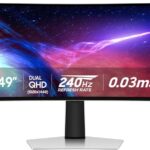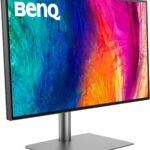In the realm of display technology, motion clarity is king. And when it comes to high-performance displays, VESA ClearMR is a game changer. You might be wondering, what exactly is VESA ClearMR? Well, it’s a cutting-edge technology designed to enhance the clarity of motion in images, particularly in high-speed scenarios like gaming or action-packed movies. If you’ve ever found yourself squinting at a blur during an intense scene, you know how crucial this technology is.
What is VESA ClearMR Technology for High-Performance Displays?
VESA ClearMR stands for Video Electronics Standards Association Clear Motion Resolution. At its core, it’s all about delivering crisp, clear images even when things are moving fast. Sounds simple, right? But the technology behind it is anything but. VESA ClearMR works by improving the way displays handle motion blur. This is crucial in high-performance displays like gaming monitors and TVs, where every millisecond counts.
The certification process for VESA ClearMR involves rigorous testing and standards to ensure that only the best displays are certified. This means that when you see a display with this certification, you can rest assured that it has met specific performance benchmarks. And let’s be honest, who doesn’t want to know they’re investing in quality tech?
Benefits of VESA ClearMR in Modern Gaming Monitors
Now, let’s get to the fun part—gaming. Ever tried playing a fast-paced game only to have the screen turn into a blurry mess? If you’re nodding your head, you’re not alone. That’s where VESA ClearMR shines. It essentially minimizes motion blur, allowing for smoother gameplay and a better overall gaming experience. This can be a game changer, especially in competitive scenarios.
Imagine playing Call of Duty or Fortnite—you need every detail to be crystal clear. With VESA ClearMR, your enemies won’t just be a smear on the screen, but rather well-defined targets. You might even find yourself getting better at aiming and dodging. And who wouldn’t want that?
The technology is not just about gaming, though. It enhances the viewing experience across the board—be it sports, action movies, or even fast-paced animations. We all remember that one movie scene where the action was so intense that the screen just couldn’t keep up. Well, with VESA ClearMR, those moments of frustration could be a thing of the past.
How VESA ClearMR Enhances Motion Clarity in TVs
Let’s pivot for a moment to TVs. You know those high-octane action movies where the camera zooms around like it’s on a rollercoaster? Without VESA ClearMR, those scenes can turn into a blurry mess—kind of like trying to watch a film through a foggy window. But with this technology, the image remains sharp and clean. Imagine watching a car chase in Fast & Furious—every turn, every drift will be visible, making you feel like you’re right in the action.
Moreover, the impact of VESA ClearMR on viewing experiences extends to sports as well. Watching a football game with players zipping back and forth across the field can be exhilarating. But if your TV can’t keep up, you might miss that game-winning goal. VESA ClearMR ensures that the details are there, enhancing your overall viewing pleasure.
VESA ClearMR vs. Traditional Motion Blur Technologies
Now, you might be thinking, “Isn’t this just another gimmick?” Well, let’s break it down. Traditional motion blur technologies often rely on various techniques, like backlight strobing or frame interpolation, to improve image clarity. But these methods can sometimes have drawbacks. For instance, backlight strobing can lead to flicker, which can be a major eyestrain factor for prolonged viewing.
On the other hand, VESA ClearMR focuses on reducing motion blur without introducing those pesky side effects. It enhances visual clarity by optimizing how the display handles fast-moving images, giving you that razor-sharp picture without the flickering headache. So, while traditional technologies have their merits, VESA ClearMR is designed with the modern viewer in mind—no compromises.
Optimizing Gaming Experience with VESA ClearMR Features
Okay, let’s talk optimization, because who doesn’t want to get the most out of their gaming setup? To really harness the power of VESA ClearMR, it’s crucial to pair it with the right hardware. This means ensuring that your gaming monitor is not just VESA ClearMR certified but also has other features that complement its capabilities, like high refresh rates and low response times.
And you know what pairs beautifully with VESA ClearMR? A solid graphics card that can push frame rates high enough to take full advantage of the technology. It’s like having a sports car but only driving it on a bumpy back road—what a waste! If you’re serious about your gaming, consider investing in hardware that maximizes the potential of VESA ClearMR.
But wait, there’s more! Many VESA ClearMR certified monitors come with additional settings that allow you to tweak the motion clarity to your liking. From adjusting response times to optimizing refresh rates, these features put you in control. Imagine feeling like a tech wizard, conjuring up the perfect gaming environment just with a few clicks. Pretty cool, right?
Understanding VESA ClearMR Certification Standards for Monitors
Now, let’s get a bit technical—don’t worry, I’ll keep it interesting! The certification process for VESA ClearMR involves a series of rigorous tests that ensure a monitor can meet specific performance benchmarks. This includes things like measuring motion clarity, assessing image quality under various motion speeds, and evaluating how well the display handles rapid transitions.
When you buy a monitor with a VESA ClearMR certification, you’re not just buying a piece of hardware; you’re investing in a promise of quality. And that’s something you can trust—especially when you consider how many monitors out there just don’t deliver.
But here’s a thought—ever wonder why some monitors seem to have sharper images than others? It’s often about the quality of the technology behind them. VESA ClearMR certification helps set a standard that consumers can rely on, ensuring that you’re not left in the dark when it comes to display quality.
Impact of VESA ClearMR on Viewing Experience in Fast-Paced Content
Let’s circle back to fast-paced content because honestly, that’s where the magic happens. Whether you’re watching the latest Marvel movie or playing a high-speed racing game, motion clarity can make or break your experience. With VESA ClearMR, you can expect a significant reduction in motion blur. This is especially beneficial for action sequences or when the camera pans quickly.
Imagine watching a thrilling chase scene—without VESA ClearMR, you might end up squinting, trying to make out the details. With it, you’ll see everything from the expressions on the actors’ faces to the nuances of a car’s design. It’s like watching a movie through a pair of high-definition glasses.
Moreover, the impact isn’t just limited to entertainment. In fields like medical imaging or even scientific research, where clarity is crucial, VESA ClearMR can enhance the viewing experience, allowing professionals to make informed decisions based on crystal-clear images.
Conclusion: Embracing the Future with VESA ClearMR
In conclusion, VESA ClearMR is not just another technical term to gloss over. It represents a significant step forward in display technology, particularly for high-performance monitors and TVs. Whether you’re a gamer, a movie buff, or a professional needing precise visuals, VESA ClearMR offers a multitude of benefits that enhance the viewing experience.
So, the next time you’re in the market for a new display, keep an eye out for VESA ClearMR certification. It could very well be the difference between a good viewing experience and a great one. And at the end of the day, who wouldn’t want the best their technology can offer?
Ultimately, embracing VESA ClearMR technology means embracing a future where motion clarity is paramount. And let’s face it—anything that helps reduce blur and enhance our favorite content is worth getting excited about. So, gear up, folks. The future of display technology is here, and it’s looking clearer than ever!
Other Related Articles
- Eizo Foris FS2331 Review
- How Much Power Does a 144Hz Monitor Use? A Deep Dive into Energy Consumption
- Should I Turn On HDR for Gaming? A Comprehensive Guide
- Is iPhone 16 Pro OLED the Best Display Yet?
- Understanding Panel Variance: What It Means for Your Monitor Purchase
- Can You Throw Computer Monitors in the Trash? The Ultimate Guide to Eco-Friendly Disposal
- Understanding VESA ClearMR: The Future of Motion Clarity in Displays
- 4K vs 1080p – Is UHD Worth The Upgrade?
- How To Choose The Right Gaming Monitor: A Comprehensive Guide
- IPS vs OLED Monitors for Color Accuracy: The Ultimate Showdown
- HDMI 2.1: The Future of Home Entertainment and Gaming
- How to Connect Heart Rate Monitor to PC?
- Curved vs Flat TV – Which Should You Choose? The Ultimate Showdown for 2025
- Can You Connect M-Audio Monitors to PC?
- Why Is My PC Showing the Same Display on Two Monitors?
- Why Are Computer Monitors More Expensive Than TVs?
- The Best Flicker-Free Monitors for Eye Care
- Monitors for Mac vs Windows PCs: The Ultimate Showdown
- 1920×1080 vs 2560×1440 – Which One Should I Choose?
- 99219444 Toshiba and Its Revolutionary Features for Tomorrow’s Tech Landscape
- OLED vs QD-OLED: The Showdown of Display Technologies
- What Is DisplayPort 2.1?
- What Is The Best Monitor Size For Gaming?
- 720p vs 1080p vs 1440p vs 4K vs 8K – Which Should I Choose?
- Is An HDR Gaming Monitor Worth It?
- Mini-LED vs MicroLED: What’s the Difference?
- Do Pawn Shops Take Computer Monitors?
- What LG Computer Monitor is as Good as the C3?
- Understanding Pixel Walk and Pixel Inversion
- Curved vs Flat Monitors for Work: Which One is Right for You?
- What Is The Soap Opera Effect?
- 4K vs 1440p Monitors for Video Editing: Which One Should You Choose?
- Do I Have to Attach a Hood to My BenQ Monitor?
- Can You Use Mac as a Monitor for PC?
- What Is G-SYNC And What Does It Do?
- Daz Studios Summoner G8 for the Visionary Artist
- Dell vs HP Monitors for Gaming
- Understanding IPS Technology: A Comprehensive Guide
- 27-Inch Monitors vs 32-Inch Monitors for Productivity
- Understanding Screen Resolution: Why It Matters for Your Displays
- How to Transport Computer Monitors?
- How to Dispose of Computer Monitors?
- What Is 4K Resolution And Is It Worth It?
- How to Pack Computer Monitor for Moving?
- What Is HDR For TVs And Is It Worth It?
- 1440p or 144Hz – Which Is Best For You?
- USB Type-C Explained – Everything You Need To Know
- Samsung’s Exciting Journey into Glasses-Free 3D Displays at Gamescom 2024
- I Have A Problem with My Samsung Odyssey G3 Monitor Setup
- Is A 144Hz Monitor Worth It? A Comprehensive Guide
- Understanding FALD Blooming and the Halo Effect: A Deep Dive
- What Does 144Hz Mean? Understanding Refresh Rates in Simple Terms
- Is an UltraWide Monitor the Right Choice for You?
- Active vs Passive 3D – What’s The Difference?
- Understanding Glare Control in Luminaires for Computer Users
- Why Does My Acer Monitor Keep Going Black?
- Understanding Motion Blur Reduction: A Gamer’s Guide
- How to Connect Studio Monitors to PC?
- Misleading Monitor Specifications You Should Look Out For
- QLED vs OLED – Which Is Best?
- Understanding VESA AdaptiveSync and MediaSync: The Future of Display Technology




